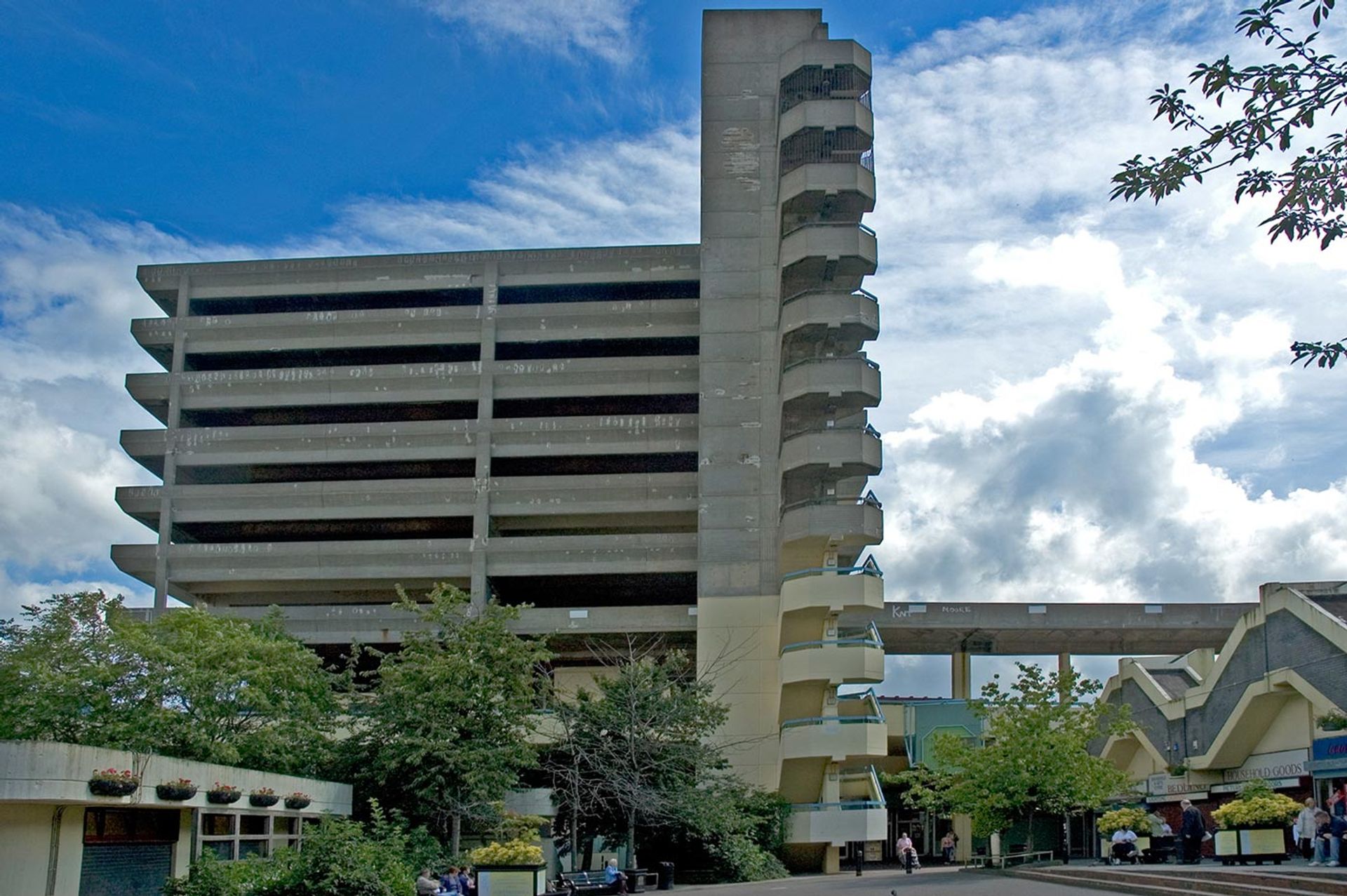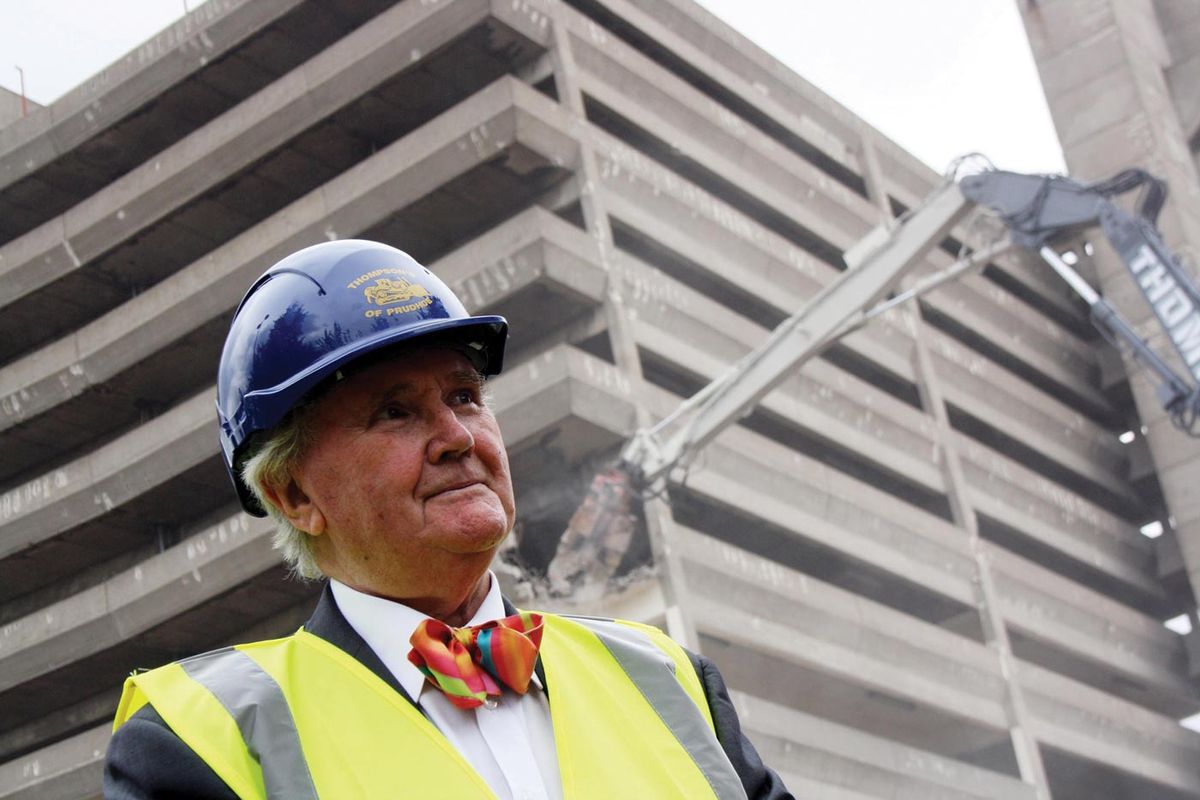The architect Owen Luder was given to being outspoken, and he will probably be best remembered for what he said in August 1982 about Richard Rogers’s unsuccessful competition entry for an extension to the National Gallery in London. “I hope they have the courage to choose that one,” Luder told The Times newspaper. “That is the work of a man who has said, ‘That is what I think the answer is, and sod you.’” Luder’s comment was all the more memorable in that, although he thought it was off the record, he was President of the Royal Institute of British Architects (RIBA) at the time and seen as speaking for the whole profession. (The gallery was ultimately enlarged by the building of the Sainsbury Wing, designed by Robert Venturi, in 1988-91.)
Those seeking evidence for Luder’s “sod you” attitude could find it in any of his three most famous early projects: Eros House, Catford, London (1963); the Tricorn Centre, Portsmouth (1964); and the Trinity Car Park and Shopping Centre, Gateshead (1967). These came about five years into his practice, established when he was 29 years old. They were led by the property developers Bernard Sunley (for Eros) and Alec Coleman (for the other two), who came to be seen as significant patrons by some, while their works were demonised by others. Two of the three were controversially demolished in the first decade of this century but a review of the Royal Academy Architecture Room in 1965 called the Gateshead project, voted in 2001 the most hated building in Britain in a Radio 4 Today programme poll, “among a few that are worth serious attention”.
The 'panache' of an Elizabethan house
The critic Ian Nairn celebrated Eros House, the sole survivor of the trio, as “a building that says something in the town, with the same kind of panache as an Elizabethan house”. The heavily modelled façade was partly the result of calculating the maximum net floor area by allowing the individual window bays different depths of projection, and disguising any faults in the concrete shuttering with a deliberately rough aesthetic. The Portsmouth project was more ambitious and its eventual commercial failure was chiefly an accident of location and later road schemes that cut off its potential footfall and deterred the hoped-for major stores from moving in. Attempts at listing made by the Twentieth Century Society and local campaigners failed, and it was demolished in 2004. Yet at the beginning this, too, was widely praised. Nairn declared “at last there is something to shout about in Portsmouth”. David Lloyd, in the original Pevsner Hampshire volume, called it “highly romantic, with many planes and varied heights and a fascinating skyline”.

Luder's Trinity Centre Car Park, Gateshead, featured in the 1971 film Get Carter Rodge500/Wikimedia
At Gateshead, a low-level shopping centre was paired with the prominent hill-top car park, surmounted by a rooftop café. The car park became a cult building, referred to as the “Get Carter” car park when Michael Caine as Jack Carter in the 1971 film beats up Cliff Brumby on one of the stairways and tips him down to land on a car bonnet below. Attempts to list Trinity also failed in a long drawn-out death agony before demolition in 2010. Luder participated in the process, declaring that with its loss, Gateshead would “lose its front teeth”. In 2012, Luder’s Derwent Tower nearby, known as the Dunston Rocket, was also demolished.
Luder personified the long-standing cultural split in the profession between “commercial” architects on one hand, and those who considered themselves gentlemen and looked down on the rest
It was an irony that his talented partner, Rodney Gordon (1933-2008), claimed that these projects were not really Luder’s designs at all, but his own. Gordon was the principal channel for whatever counts as Brutalist in these massive concrete structures, since he had been taught by Peter Smithson, one of the originators of the term, at the Architectural Association. Denis Drawbridge, a colleague of Gordon’s at the London County Council (LCC), had been moonlighting for Luder, and in 1958 invited him to meet Alec Coleman, with whom Luder wanted to submit a design for a shopping centre at Elephant and Castle, south London, but needed a designer. As Gordon explained, “to us at the LCC, the private commercial sector on the whole represented the antithesis of creative architecture”. But he came to realise instead that working for Luder and developers, he would have the freedom to bring his student drawing-board dreams to life. “Owen Luder was an amiable bloke,” Gordon explained, “who spoke developer language with a cockney accent… He appeared to be very good at his job and was obviously poised to obtain a lot of work.”
Luder personified the long-standing cultural split in the profession between “commercial” architects on one hand, and those who considered themselves gentlemen and looked down on the rest. His best-known counterpart, everyone’s favourite villain in architecture in the later 1960s, was Richard Seifert, for whom George Marsh acted in a similar capacity to Rodney Gordon, and whose claims to authorship Seifert tended to brush aside, as Luder did with Gordon. Both architects worked in a collaborative manner, and Luder had other trusted partners in his expanding practice.
A snappy dresser with a taste for bow-ties
Born in 1928 in Islington, north London, Luder grew up in south London, taking the surname of his stepfather and never knowing who his real father had been. After wartime schooling he entered the Brixton School of Building, learning practical trades, and then taking classes at the Regent Street Polytechnic before passing his professional exams with ease. He was a snappy dresser with a taste for bow-ties. In the 1950s, he became “the king of the ladies’ hairdressing salons”, making them glamorous for the first time. At the same time (1954), he got his name in The Times for a scheme to build a heliport over the top of Hungerford Bridge, right next to London’s newest concert hall in the South Bank.
There is a feeling that somehow profitability and good architecture cannot be combined. But nothing is further from the truthOwen Luder
Combining cheekiness with common sense, Luder, whose accountant attended all the partners’ meetings, became treasurer of the RIBA in the 1970s and increasingly critical of its almost deliberate lack of business acumen and failure to promote the profession. He wrote: “I have always found it strange that the more academic section of the profession should look with disdain on architectural practices that are eminently and obviously financially successful. There is a feeling that somehow profitability and good architecture cannot be combined. But nothing is further from the truth”. Luder’s operation had offices at different times in Newcastle, Birmingham, Cardiff and Lagos; he also worked in Saudi Arabia and Iran.
Luder admitted to being a trouble-maker, “shouting my head off” about the public affairs of the RIBA and was riled by the refusal of Gordon Graham—the president of the RIBA 1977-79—to appoint him as his vice-president. For 60 years, this position had automatically led to the presidency, so Luder decided to break the unwritten code and stand for election against Andrew Derbyshire. A third candidate, Jake Brown, a Greater London Council (GLC) architect, also entered the race, which was won by Luder, who returned for a second term in 1995-97. He left his practice in 1987 and turned to consultancy.
The range of work contained in Luder’s 1977 practice monograph, Adventure in Architecture, is varied, even soft and gentle at times, unlike the concrete behemoths with which he is associated. The anonymous author of the Wikipedia entry on Luder is right in claiming, “He is labelled as a Brutalist architect but his work is far more extensive, subtle, and influential than that term dictates. The Owen Luder Partnership’s work is deserving of re-evaluation.”
Harold Owen Luder; born London 7 August 1928; President, RIBA, 1981-83 and 1995-97; married 1951 Doris Broadstock (died 2010; one son deceased and four daughters; marriage dissolved 1989), 1989 Jacqueline Ollerton (died 2008); died 8 October 2021.


